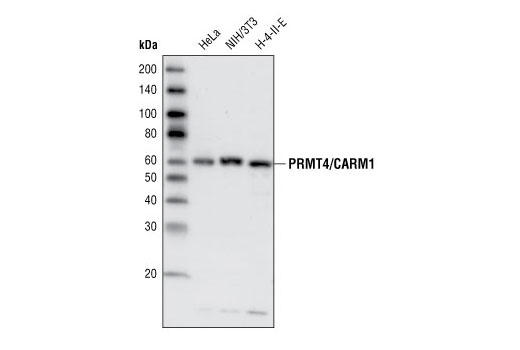WB, IP
H M R Mk
Endogenous
63
Rabbit
#Q86X55
10498
Product Information
Product Usage Information
| Application | Dilution |
|---|---|
| Western Blotting | 1:1000 |
| Immunoprecipitation | 1:50 |
Storage
Specificity / Sensitivity
Species Reactivity:
Human, Mouse, Rat, Monkey
Source / Purification
Polyclonal antibodies are produced by immunizing animals with a synthetic peptide corresponding to the carboxy terminus of the human PRMT4/CARM1 protein. Antibodies are purified by protein A and peptide affinity chromatography.
Background
Protein arginine N-methyltransferase 4 (PRMT4), also known as coactivator-associated arginine methyltransferase 1 (CARM1), is a member of the protein arginine N-methyltransferase (PRMT) family of proteins, which catalyze the transfer of a methyl group from S-adenosylmethionine (AdoMet) to a guanidine nitrogen of arginine (1). There are two types of PRMT proteins. While both types catalyze the formation of mono-methyl arginine, type I PRMTs (PRMT1, 3, 4 and 6) add an additional methyl group to produce asymmetric di-methyl arginine and type II PRMTs (PRMT 5 and 7) produce symmetric di-methyl arginine (1). Mono-methyl arginine, but not di-methyl arginine, can be converted to citrulline through deimination performed by enzymes such as PADI4 (2). Most of the PRMTs methylate arginine residues found within glycine-arginine rich (GAR) domains of proteins, such as RGG, RG and RXR repeats (1). However, PRMT4/CARM1 and PRMT5 instead methylate arginine residues within PGM (proline-, glycine-, methionine-rich) motifs (3). PRMT4 methylates Arg2, 17 and 26 of histone H3 and cooperates synergistically with p300/CBP and p160 coactivators to enhance transcriptional activation by nuclear receptor proteins (4). In addition, PRMT4 methylates many non-histone proteins, including transcriptional coactivators (p300/CBP, SRC-3) (5,6,7,8), splicing factors (SmB, CA150, SAP49, UIC) (3), RNA binding proteins (PABP1, Sam68, HuD, HuR) (9,10,11), and thymocyte cyclic AMP-regulated phosphoprotein (TARPP) (12), suggesting additional functions in transcriptional regulation, mRNA processing and thymocyte maturation. Methylation of the splicing factor CA150 by PRMT4 facilitates an interaction with the Tudor domain of SMN, suggesting a role for PRMT4 in spinal muscular atrophy (3).
- Bedford, M.T. and Richard, S. (2005) Mol. Cell 18, 263-272.
- Wang, Y. et al. (2004) Science 306, 279-283.
- Cheng, D. et al. (2007) Mol. Cell 25, 71-83.
- Chen, D. et al. (2000) J. Biol. Chem. 275, 40810-40816.
- Lee, Y.H. et al. (2005) Proc. Natl. Acad. Sci. USA 102, 3611-3616.
- Xu, W. et al. (2001) Science 294, 2507-2511.
- Naeem, H. et al. (2007) Mol. Cell Biol. 27, 120-134.
- Feng, Q. et al. (2006) Mol. Cell Biol. 26, 7846-7857.
- Lee, J. and Bedford, M.T. (2002) EMBO Rep. 3, 268-273.
- Côté, J. et al. (2003) Mol. Biol. Cell 14, 274-287.
- Fujiwara, T. et al. (2006) Mol. Cell Biol. 26, 2273-2285.
- Kim, J. et al. (2004) J. Biol. Chem. 279, 25339-25344.
Species Reactivity
Species reactivity is determined by testing in at least one approved application (e.g., western blot).
Western Blot Buffer
IMPORTANT: For western blots, incubate membrane with diluted primary antibody in 5% w/v nonfat dry milk, 1X TBS, 0.1% Tween® 20 at 4°C with gentle shaking, overnight.
Applications Key
WB: Western Blotting IP: Immunoprecipitation
Cross-Reactivity Key
H: human M: mouse R: rat Hm: hamster Mk: monkey Vir: virus Mi: mink C: chicken Dm: D. melanogaster X: Xenopus Z: zebrafish B: bovine Dg: dog Pg: pig Sc: S. cerevisiae Ce: C. elegans Hr: horse GP: Guinea Pig Rab: rabbit All: all species expected
Trademarks and Patents
Limited Uses
Except as otherwise expressly agreed in a writing signed by a legally authorized representative of CST, the following terms apply to Products provided by CST, its affiliates or its distributors. Any Customer's terms and conditions that are in addition to, or different from, those contained herein, unless separately accepted in writing by a legally authorized representative of CST, are rejected and are of no force or effect.
Products are labeled with For Research Use Only or a similar labeling statement and have not been approved, cleared, or licensed by the FDA or other regulatory foreign or domestic entity, for any purpose. Customer shall not use any Product for any diagnostic or therapeutic purpose, or otherwise in any manner that conflicts with its labeling statement. Products sold or licensed by CST are provided for Customer as the end-user and solely for research and development uses. Any use of Product for diagnostic, prophylactic or therapeutic purposes, or any purchase of Product for resale (alone or as a component) or other commercial purpose, requires a separate license from CST. Customer shall (a) not sell, license, loan, donate or otherwise transfer or make available any Product to any third party, whether alone or in combination with other materials, or use the Products to manufacture any commercial products, (b) not copy, modify, reverse engineer, decompile, disassemble or otherwise attempt to discover the underlying structure or technology of the Products, or use the Products for the purpose of developing any products or services that would compete with CST products or services, (c) not alter or remove from the Products any trademarks, trade names, logos, patent or copyright notices or markings, (d) use the Products solely in accordance with CST Product Terms of Sale and any applicable documentation, and (e) comply with any license, terms of service or similar agreement with respect to any third party products or services used by Customer in connection with the Products.

